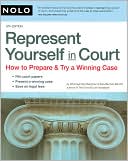Making Your Case: The Art of Persuading Judges
In their professional lives, courtroom lawyers must do these two things well: speak persuasively and write persuasively. In this noteworthy book, two noted legal writers systematically present every important idea about judicial persuasion in a fresh, entertaining way. The book covers the essentials of sound legal reasoning, including how to develop the syllogism that underlies any argument. From there the authors explain the art of brief writing, especially what to include and what to omit,...
Search in google:
In their professional lives, courtroom lawyers must do these two things well: speak persuasively and write persuasively. In this noteworthy book, two noted legal writers systematically present every important idea about judicial persuasion in a fresh, entertaining way. The book covers the essentials of sound legal reasoning, including how to develop the syllogism that underlies any argument. From there the authors explain the art of brief writing, especially what to include and what to omit, so that you can induce the judge to focus closely on your arguments. Finally, they show what it takes to succeed in oral argument.
Acknowledgments ixForeword xixIntroduction xxiGeneral Principles of Argumentation 1Be sure that the tribunal has jurisdiction 3Know your audience 5Know your case 8Know your adversary's case 10Pay careful attention to the applicable standard of decision 11Never overstate your case. Be scrupulously accurate 13If possible, lead with your strongest argument 14If you're the first to argue, make your positive case and then preemptively refute in the middle-not at the beginning or end 15If you're arguing after your opponent, design the order of positive case and refutation to be most effective according to the nature of your opponent's argument 17Occupy the most defensible terrain 19Yield indefensible terrain-ostentatiously 20Take pains to select your best arguments. Concentrate your fire 22Communicate clearly and concisely 23Always start with a statement of the main issue before fully stating the facts 25Appeal not just to rules but to justice and common sense 26When you must rely on fairness to modify the strict application of the law, identify some jurisprudential maxim thatsupports you 30Understand that reason is paramount with judges and that overt appeal to their emotions is resented 31Assume a posture of respectful intellectual equality with the bench 33Restrain your emotions. And don't accuse 34Control the semantic playing field 35Close powerfully-and say explicitly what you think the court should do 37Legal Reasoning 39In GeneralThink syllogistically 41Statutes, Regulations, Ordinances, Contracts, and the LikeKnow the rules of textual interpretation 44In cases controlled by governing legal texts, always begin with the words of the text to establish the major premise 46Be prepared to defend your interpretation by resort to legislative history 48CaselawMaster the relative weight of precedents 52Try to find an explicit statement of your major premise in governing or persuasive cases 55Briefing 57IntroductionAppreciate the objective of a brief 59Preparatory StepsStrengthen your command of written English 61Consult the applicable rules of court 64Set timelines for the stages of your work 66In cooperation with your opponent, prepare the Joint Appendix 68The Writing ProcessSpend plenty of time simply "getting" your arguments 69Outline your brief 70Opening Brief 71Responding Brief 71Reply Brief 73Petition for Discretionary Review 75Response to a Petition for Discretionary Review 79Sit down and write. Then revise. Then revise again. Finally, revise 80Architecture and StrategyKnow how to use and arrange the parts of a brief 82Questions Presented 83Statement of Parties in Interest 89Table of Contents; Table of Authorities 89Constitutional and Statutory Authorities 90Statement of Jurisdiction 91Introduction or Preliminary Statement 91Proceedings Below 92Statement of Facts 93Summary of Argument 97Argument 98Conclusion 100Appendix 101Advise the court by letter of significant authority arising after you've filed your brief 101Learn how to use, and how to respond to, amicus briefs 102Writing StyleValue clarity above all other elements of style 107Use captioned section headings 108Use paragraphs intelligently; signpost your arguments 109To clarify abstract concepts, give examples 111Make it interesting 112Banish jargon, hackneyed expressions, and needless Latin 113Consider using contractions occasionally-or not 114Avoid acronyms. Use the parties' names 120Don't overuse italics; don't use bold type except in headings; don't use underlining at all 122Describe and cite authorities with scrupulous accuracy 123Cite authorities sparingly 125Quote authorities more sparingly still 127Swear off substantive footnotes-or not 129Consider putting citations in footnotes-or not 132Make the relevant text readily available to the court 135Don't spoil your product with poor typography 136Oral Argument 137IntroductionAppreciate the importance of oral argument, and know your objectives 139Long-Term PreparationPrepare yourself generally as a public speaker 142Master the preferred pronunciations of English words, legal terms, and proper names 144Master the use of the pause 146Preliminary Decision: Who Will Argue?Send up the skilled advocate most knowledgeable about the case 147Avoid splitting the argument between cocounsel 148Months and Weeks Before ArgumentPrepare assiduously 150Learn the record 151Learn the cases 152Decide which parts of your brief you'll cover 153Be flexible 153Be absolutely clear on the theory of your case 155Be absolutely clear on the mandate you seek 156Organize and index the materials you may need 157Conduct moot courts 158Watch some arguments 159On the eve of argument, check your authorities 160Before You SpeakArrive at court plenty early with everything you need 161Make a good first impression. Dress appropriately and bear yourself with dignity 162Seat only cocounsel at counsel table 163Bear in mind that even when you're not on your feet, you're onstage and working 163Approach the lectern unencumbered; adjust it to your height; stand erect and make eye contact with the court 164Substance of ArgumentGreet the court and, if necessary, introduce yourself 166Have your opener down pat 167If you're the appellant, reserve rebuttal time 167Decide whether it's worth giving the facts and history of the case 168If you're the appellant, lead with your strength 169If you're the appellee, take account of what has preceded, clear the underbrush, and then go to your strength 170Avoid detailed discussion of precedents 171Focus quickly on crucial text, and tell the court where to find it 172Don't beat a dead horse. Don't let a dead horse beat you 172Stop promptly when you're out of time 173When you have time left, but nothing else useful to say, conclude effectively and gracefully 173Take account of the special considerations applicable to rebuttal argument 175Manner of ArgumentLook the judges in the eye. Connect 178Be conversational but not familiar 179Use correct courtroom terminology 180Never read an argument; never deliver it from memory except the opener and perhaps the closer 181Treasure simplicity 182Don't chew your fingernails 183Present your argument as truth, not as your opinion 184Never speak over a judge 184Never ask how much time you have left 185Never (or almost never) put any other question to the court 186Be cautious about humor 186Don't use visual aids unintelligently 187Handling QuestionsWelcome questions 189Listen carefully and, if necessary, ask for clarification 191Never postpone an answer 192If you don't know, say so. And never give a categorical answer you're unsure of 193Begin with a "yes" or a "no" 193Never praise a question 194Willingly answer hypotheticals 194After answering, transition back into your argument-smoothly, which means not necessarily at the point where you left it 195Recognize friendly questions 196Learn how to handle a difficult judge 196Beware invited concessions 199After the BattleAdvise the court of significant new authority 201If you're unhappy with the ruling, think about filing a motion for reconsideration 201Learn from your mistakes 205Plan on developing a reputation for excellence 205Sources for Inset Quotations 207Recommended Sources 213Index 219







